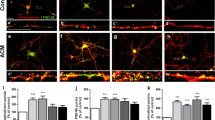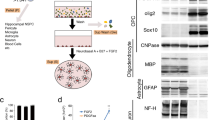1. Secretory pathway Ca2+ ATPase type 1 (SPCA1) is a newly recognized Ca2+/Mn2+-transporting pump localized in membranes of the Golgi apparatus.
2. The expression level of SPCA1 in brain tissue is relatively high in comparison with other tissues.
3. With the aim to determine the expression of SPCA1 within the different types of neural cells, we investigated the distribution of SPCA1 in neuronal, astroglial, oligodendroglial, ependymal, and microglial cell cultures derived from rat brains.
4. Western Blot analysis with rabbit anti-SPCA1 antibodies revealed the presence of SPCA1 in homogenates derived from neuronal, astroglial, ependymal, and oligodendroglial, but not from microglial cells.
5. Cell cultures that gave rise to positive signal in the immunoblot analysis were also examined immunocytochemically.
6. Immunocytochemical double-labeling experiments with anti-SPCA1 serum in combination with antibodies against cell-type specific proteins showed a localization of the SPCA1signal within cells stained positively also for GFAP, α-tubulin or MBP.
7. These results definitely established the expression of SPCA1 in astroglial, ependymal, and oligodendroglial cells.
8. In addition, the evaluation of neuronal cultures for the presence of SPCA1 revealed an SPCA1-specific immunofluorescence signal in cells identified as neurons.





Similar content being viewed by others
REFERENCES
Calegari, F., Coco, S., Taverna, E., Bassetti, M., Verderio, C., Corradi, N., Matteoli, M., and Rosa, P. A. (1999). Regulated secretory pathway in cultured hippocampal astrocytes. J. Biol. Chem. 274:22539–22547.
Canaff, L., Brechler, V., Reudelhuber, T. L., and Thibault, G. (1996). Secretory granule targeting of atrial natriuretic peptide correlates with its calcium-mediated aggregation. Proc. Natl. Acad. Sci. U.S.A. 93:9483–9487.
Carnell, L., and Moore, H. P. (1994). Transport via the regulated secretory pathway in semi-intact PC12 cells: Role of intra-cisternal calcium and pH in the transport and sorting of secretogranin II. J. Cell Biol. 127:693–705.
Chandra, S., Kable, E. P., Morrison, G. H., and Webb, W. W. (1991). Calcium sequestration in the Golgi apparatus of cultured mammalian cells revealed by laser scanning confocal microscopy and ion microscopy. J. Cell Sci. 100:747–752.
Chandra, S., Fewtrell, C., Millard, P. J., Sandison, D. R., Webb, W. W., and Morrison, G. H. (1994). Imaging of total intracellular calcium and calcium influx and efflux in individual resting and stimulated tumor mast cells using ion microscopy. J. Biol. Chem. 269:15186–15194.
Evanko, D. S., Zhang, Q., Zorec, R., and Haydon, P. G. (2004). Defining pathways of loss and secretion of chemical messengers from astrocytes. Glia 47:233–240.
Giulian, D., and Baker, T. J. (1986). Characterization of ameboid microglia isolated from developing mammalian brain. J. Neurosci. 6:2163–2178.
Hamprecht, B., and Loffler, F. (1985). Primary glial cultures as a model for studying hormone action. Methods Enzymol. 109:341–345.
Hirrlinger, J., Gutterer, J. M., Kussmaul, L., Hamprecht, B., and Dringen, R. (2000). Microglial cells in culture express a prominent glutathione system for the defense against reactive oxygen species. Dev. Neurosci. 22:384–392.
Hirrlinger, J., Resch, A., Gutterer, J. M., and Dringen, R. (2002). Oligodendroglial cells in culture effectively dispose of exogenous hydrogenperoxide: Comparison with cultured neurones, astroglial and microglial cells. J. Neurochem. 82:635–644.
Hu, Z., Bonifas, J. M., Beech, J., Bench, G., Shigihara, T., Ogawa, H., Ikeda, S., Mauro, T., and Epstein, E. H. Jr. (2000). Mutations in ATP2C1, encoding a calcium pump, cause Hailey-Hailey disease. Nat. Genet. 24:61–65.
Löffler, F., Lohmann, S. M., Walckhoff, B., Walter, U., and Hamprecht, B. (1986). Immunocytochemical characterization of neuron-rich primary cultures of embryonic rat brain cells by established neuronal and glial markers and by monospecific antisera against cyclic nucleotide-dependent protein kinases and the synaptic vesicle protein synapsin I. Brain Res. 363:205–221.
Michelangeli, F., Ogunbayo, O. A., and Wootton, L. L. (2005). A plethora of interacting organellar Ca2+ stores. Curr. Opin. Cell. Biol. 17:135–140.
Pezzati, R., Bossi, M., Podini, P., Meldolesi, J., and Grohovaz, F. (1997). High-resolution calcium mapping of the endoplasmic reticulum-Golgi-exocytic membrane system. Electron energy loss imaging analysis of quick frozen-freeze dried PC12 cells. Mol. Biol. Cell. 8:1501–1512.
Pinton, P., Pozzan, T., and Rizzuto, R. (1998). The Golgi apparatus is an inositol 1,4,5-trisphosphate-sensitive Ca2+ store, with functional properties distinct from those of the endoplasmic reticulum. EMBO J. 17:5298–5308.
Prothmann, C., Wellard, J., Berger, J., Hamprecht, B., and Verleysdonk, S. (2001). Primary cultures as a model for studying ependymal functions: Glycogen metabolism in ependymal cells. Brain Res. 920:74–83.
Sudbrak, R., Brown, J., Dobson-Stone, C., Carter, S., Ramser, J., White, J., Healy, E., Dissanayake, M., Larregue, M., Perrussel, M., Lehrach, H., Munro, C. S., Strachan, T., Burge, S., Hovnanian, A., and Monaco, A. P. (2000). Hailey-Hailey disease is caused by mutations in ATP2C1 encoding a novel Ca(2+) pump. Hum. Mol. Genet. 9:1131–1140.
Surroca, A., and Wolff, D. (2000). Inositol 1,4,5-trisphosphate but not ryanodine-receptor agonists indu-ces calcium release from rat liver Golgi apparatus membrane vesicles. J. Membr. Biol. 177:243–249.
Sytnyk, V., Leshchyns’ka, I., Dityatev, A., and Schachner, M. (2004). Trans-Golgi network delivery of synaptic proteins in synaptogenesis. J. Cell. Sci. 117:381–388.
Ton, V. K., Mandal, D., Vahadji, C., and Rao, R. (2002). Functional expression in yeast of the human secretory pathway Ca(2+), Mn(2+)-ATPase defective in Hailey-Hailey disease. J. Biol. Chem. 277:6422–6427.
Van Baelen, K., Vanoevelen, J., Callewaert, G., Parys, J. B., De Smedt, H., Raeymaekers, L., Rizzuto, R., Missiaen, L., Wuytack, F. (2001). The contribution of the SPCA1 Ca2+ pump to the Ca2+ accumulation in the Golgi apparatus of HeLa cells assessed via RNA-mediated interference. Biochem. Biophys. Res. Commun. 306:430–436.
Van Baelen, K., Dode, L., Vanoevelen, J., Callewaert, G., De Smedt, H., Missiaen, L., Parys, J. B., Raeymaekers, L., and Wuytack, F. (2004). The Ca2+/Mn2+ pumps in the Golgi apparatus. Biochim. Biophys. Acta 1742:103–112.
Vanoevelen, J., Dode, L., Van Baelen, K., Fairclough, R. J., Missiaen, L., Raeymaekers, L., and Wuytack, F. (2005). The secretory pathway Ca2+/Mn2+-ATPase 2 is a Golgi-localized pump with high affinity for Ca2+ ions. J. Biol. Chem. 280:22800–22808.
Volterra, A., and Meldolesi, J. (2005). Astrocytes, from brain glue to communication elements: The revolution continues. Nat. Rev. Neurosci. 8:626–640.
Wootton, L. L., Argent, C. C. A., Wheatley, M., and Michelangeli, F. (2004). The expression, activity and localisation of the secretory pathway Ca2+-ATPase (SPCA1) in different mammalian tissues. Biochim. Biophys. Acta 1664:189–197.
Wuytack, F., Raeymaekers, L., and Missiaen, L. (2002). Molecular physiology of the SERCA and SPCA pumps. Cell Calcium 32:279–305.
Xiang, M., Mohamalawari, D., and Rao, R. (2005). A novel isoform of the secretory pathway Ca2+, Mn(2+)-ATPase, hSPCA2, has unusual properties and is expressed in the brain. J. Biol. Chem. 280:11608–11614.
ACKNOWLEDGMENTS
The authors would like to thank Barbara Birk for her expert technical help in the preparation of the ependymal cell cultures. Part of this work was presented as an abstract on the 5th International Symposium on Experimental and Clinical Neurobiology, Tatranska Lomnica-Stara Lesna, Slovak Republic, September 2005. This study was supported by research grants: VEGA No. 1/0034/03, VEGA No. 3380/06, APVT No. 51-127404, and MVTS 39.
Author information
Authors and Affiliations
Corresponding author
Rights and permissions
About this article
Cite this article
Murín, R., Verleysdonk, S., Raeymaekers, L. et al. Distribution of Secretory Pathway Ca2+ ATPase (SPCA1) in Neuronal and Glial Cell Cultures. Cell Mol Neurobiol 26, 1353–1363 (2006). https://doi.org/10.1007/s10571-006-9042-z
Received:
Accepted:
Published:
Issue Date:
DOI: https://doi.org/10.1007/s10571-006-9042-z




